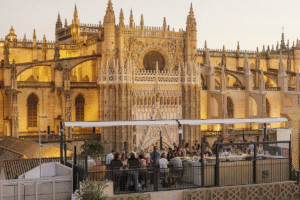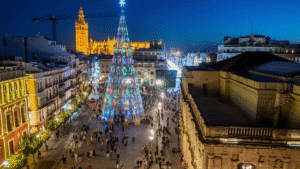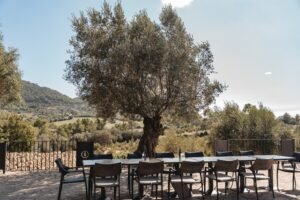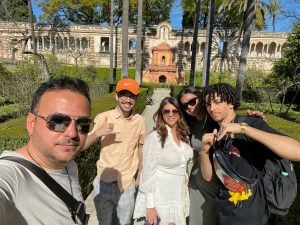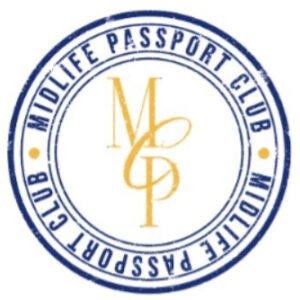November transforms Seville into something special. The sweltering summer crowds have vanished, the temperatures have mellowed to perfection, and the city reveals its most authentic character. If you’re planning a trip to this captivating Andalusian capital during autumn, you’re in for a treat that combines comfortable weather, cultural richness, and the kind of breathing room that lets you truly experience the city.
Why November is the Secret Best Time to Visit Seville
Let’s be honest: Seville in summer can be brutal. We’re talking 40°C (104°F) heat that sends even locals retreating indoors during midday. But November? It’s a completely different story. Lets chat Seville in November.
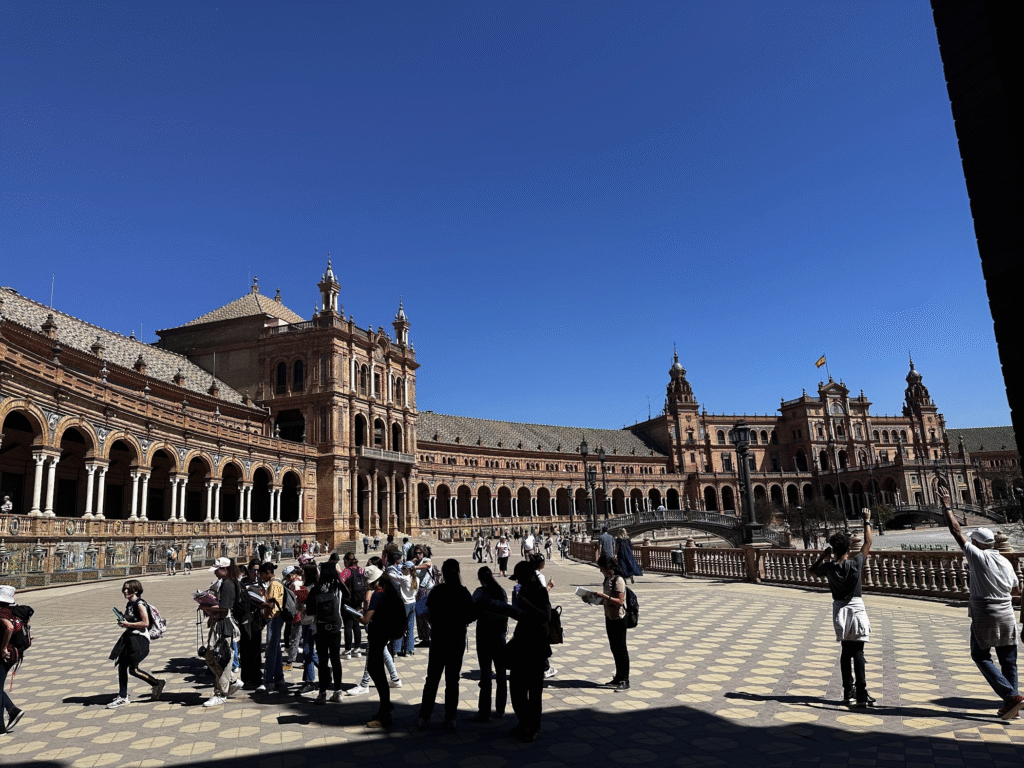
The average temperatures in November range from a pleasant 9-20°C (47-67°F), with daytime highs around 20°C (68°F) and cooler evenings that make evening strolls absolutely magical. You’ll enjoy approximately 10 hours of daylight each day, with sunrise around 8:00 AM and sunset around 6:15 PM. The city still gets about 5 hours of bright sunshine daily, giving you plenty of golden light for photography without the harsh glare and oppressive heat that makes summer sightseeing feel like an endurance test.
More importantly, the tourist crowds have dispersed. Those “skip the line” tickets that websites frantically recommend for summer visits? Many travelers report buying tickets at the door in November with no issues. You’ll actually be able to appreciate the Real Alcázar’s intricate tilework without being jostled by tour groups, and your Instagram photos won’t feature dozens of strangers photobombing your shots.
Budget travelers will love November too. Hotels that charge premium prices during peak season become significantly more affordable, and you might even score incredible flight deals during Black Friday and Cyber Monday. Some travelers have snagged return flights for under £20—that’s less than a fancy dinner.
This post contains affiliate links.
The Unmissable Seville Experiences
Explore the Real Alcázar at Your Own Pace
The Real Alcázar is Seville’s crown jewel—a UNESCO World Heritage site and Europe’s oldest palace still in royal use. This architectural masterpiece showcases centuries of evolution, from Mudéjar foundations to Gothic and Renaissance additions, with vibrant azulejo tiles, ornate columns, and intricate carvings at every turn.
Game of Thrones fans will recognize the Courtyard of the Maidens (the Water Gardens of Dorne). November’s cooler weather means you can comfortably spend hours exploring the palace and its stunning gardens—in summer, the heat becomes unbearable. Even during off-season, tickets can sell out by late morning, so book in advance or arrive right at opening (9:30 AM).
Consider a guided tour combining the Alcázar with the Cathedral and Giralda Tower for historical context that brings the architecture to life.
Also check out NYE In Malaga.
Climb the Giralda Tower for Panoramic Views
The Giralda, a former minaret turned cathedral bell tower, features ramps instead of steps (originally designed for guards on horseback). The climb takes you past Gothic details to the top at 104 meters, where you’ll find 360-degree panoramas of Seville’s terracotta rooftops, the Guadalquivir River, and sprawling cityscape.
The tower adjoins Seville Cathedral, one of the world’s largest churches built to demonstrate the city’s wealth after the Reconquista. Inside, you’ll find Christopher Columbus’s tomb, priceless artwork, and ornate chapels that require craning your neck to take in.

Also check out New Year’s Eve in Seville.
Experience Authentic Flamenco in Triana
You cannot visit Seville without experiencing flamenco. Triana, the neighborhood across the river, is considered the birthplace of this passionate art form and where you’ll find the most authentic performances.
Several tablaos (flamenco venues) offer nightly shows. Casa de la Memoria provides intimate performances in a 16th-century building with classical guitar, rhythmic heel-clicking, and spine-tingling vocals. Los Gallos features flamenco elite in one of Seville’s oldest tablaos, while Tablao Pura Esencia performs in Triana’s heart.
Book at least a day ahead, especially weekends. Shows typically last 60-90 minutes and often include a complimentary drink. If you’re visiting mid-November, consider a trip to nearby Alcalá de Guadaíra for the Soleá de Alcalá Flamenco Singing Contest.
Also check out Seville in Christmas.
Get Lost in the Barrio Santa Cruz
The Jewish Quarter, or Barrio Santa Cruz, is Seville at its most photogenic—a maze of narrow alleyways, whitewashed buildings with wrought-iron balconies, hidden plazas, and climbing bougainvillea.
Getting lost is part of the charm. Wander without a map and discover tiny tapas bars, artisan workshops, centuries-old churches, and courtyards fragrant with orange blossoms. November’s comfortable temperatures and softer light create perfect conditions for photography and exploring these narrow streets.
Don’t miss Plaza de Santa Cruz, a charming square with outdoor cafes, and the Hospital de los Venerables, a former priests’ retirement home housing a remarkable art collection.
Marvel at Plaza de España
Built for the 1929 Ibero-American Exposition, Plaza de España is one of Seville’s most photographed spots. This semi-circular complex features a massive brick building decorated with tiles, fountains, bridges spanning a canal, and 48 alcoves representing Spanish provinces with intricate tilework.
You can rent rowboats to paddle the canal, take horse-drawn carriage rides, or simply soak in the architectural spectacle. Film buffs will recognize it from Star Wars: Episode II and Lawrence of Arabia.
November provides perfect conditions for exploring the entire plaza and its 48 provincial alcoves. The plaza sits within Maria Luisa Park, which becomes especially beautiful in autumn when leaves turn gold, orange, and red, creating a fairy-tale atmosphere.
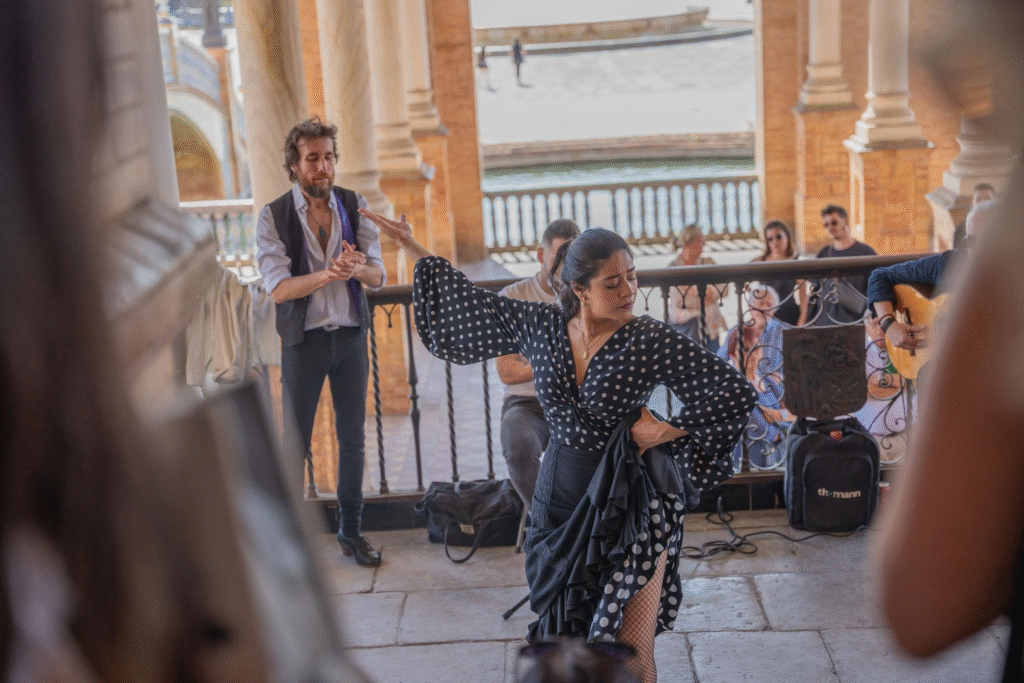
November-Specific Activities
Savor Seasonal Andalusian Cuisine
November is prime time for Andalusian gastronomy. The grape harvest has just concluded, mushroom season is beginning, and olive oil production is underway. This means you’ll find the freshest seasonal ingredients at tapas bars throughout the city.
Traditional Spanish dishes shine in November. Look for hearty stews, roasted chestnuts sold by street vendors, sweet potato preparations, and dishes featuring freshly foraged mushrooms. The cooler weather makes comfort food especially appealing, and sitting at an outdoor terrace with a plate of tapas and a glass of local wine is one of Seville’s great pleasures.
Don’t miss trying local specialties like salmorejo (a creamy cold tomato soup thicker than gazpacho), pescaíto frito (fried fish), espinacas con garbanzos (spinach with chickpeas), and anything featuring jamón ibérico.
The beauty of tapas culture is that you can sample many different dishes in one evening. Bar-hopping through different neighborhoods—starting in Triana, moving to the Alameda de Hércules area, and finishing in the city center—gives you a delicious cross-section of Sevillian cuisine.
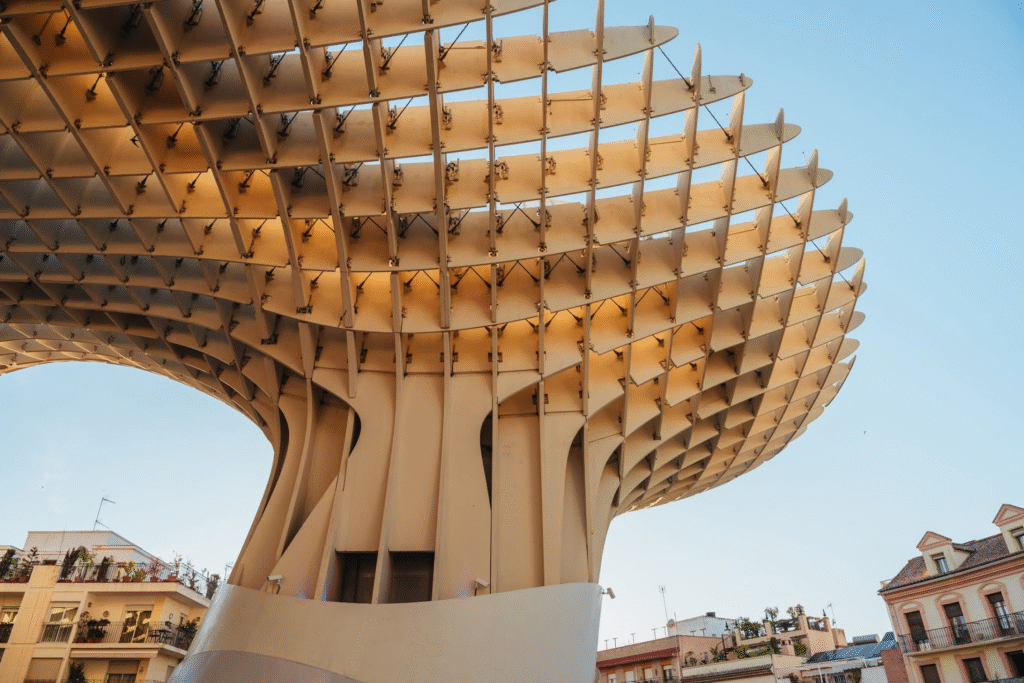
Attend the Sevilla Festival de Cine Europeo
Film enthusiasts should time their visit to coincide with the Sevilla Festival de Cine Europeo (Seville European Film Festival), typically held in early to mid-November. This event showcases the best new European cinema, with diverse selections from multiple countries and opportunities to hear from filmmakers themselves.
The festival attracts top European talent and offers everything from dramatic narratives to documentaries to experimental films. Even if you’re not a hardcore cinephile, catching a film or two provides a unique cultural experience and a welcome indoor activity if November rains appear.
Take a Day Trip to Italica
Just 10 kilometers from Seville lies one of the most impressive archaeological sites in Spain: Italica. This ancient Roman city, now part of the town of Santiponce, was once the largest Roman settlement in Spain and remains remarkably well-preserved.
Italica’s highlights include one of the Roman Empire’s largest amphitheaters, capable of seating 25,000 spectators. You can walk through the arena and imagine gladiatorial contests that took place nearly two millennia ago. The site also features five grand houses belonging to prosperous families, with intricate mosaic floors where even the tiniest tiles remain perfectly positioned.
November is ideal for visiting Italica because the site offers minimal shade. In summer, exploring ruins under the Andalusian sun is punishing; in November, the temperatures are just right for outdoor archaeological exploration. You can reach Italica by taking bus #172 from Plaza de Armas—an easy and affordable day trip.

Explore Seville’s Museum Scene on Rainy Days
November can bring some rainfall (averaging about 2.7 inches for the month), but that doesn’t mean your plans need to suffer. Seville boasts dozens of fascinating museums that provide perfect rainy-day refuges.
The Museum of Fine Arts (Museo de Bellas Artes) is Spain’s second-most important art gallery, housed in a beautiful former convent. The collection spans from the Middle Ages to the early 20th century, featuring masterpieces by Murillo, Zurbarán, and Velázquez.
The Flamenco Dance Museum offers an interactive journey through flamenco’s history, complete with costumes, photographs, and regular dance performances. It’s a perfect complement to attending a live show.
The Archaeological Museum showcases treasures from Italica and other Roman sites, plus artifacts from Seville’s Moorish period. The Museo del Baile Flamenco provides another deep dive into this quintessentially Spanish art form.
For something different, visit the Maestranza Bullring and Museum to learn about bullfighting’s history and cultural significance, even if you’re not interested in attending an actual bullfight.
Walk the Metropol Parasol
For a complete change of architectural pace, head to the Metropol Parasol, nicknamed “Las Setas” (The Mushrooms) by locals. This massive modern wooden structure in Plaza de la Encarnación looks like something from a science fiction film.
Designed by German architect Jürgen Mayer, Las Setas opened in 2011 and immediately became controversial—some love its contemporary boldness, others think it clashes with Seville’s historic character. Regardless of your opinion, the top level offers excellent panoramic views of the city, and the structure creates valuable shade for the plaza below.
The ground level houses a market and bars, while the basement contains archaeological remains from Roman and Moorish periods, discovered during construction. An elevated walkway lets you stroll across the top of the structure, providing a unique perspective on Seville’s skyline.
Getting to Seville and Getting Around
From the Airport to City Center
Seville Airport (SVQ) sits about 10 kilometers northeast of the city center, making it one of Europe’s most convenient airports for reaching downtown. You have several transport options:
Airport Bus (EA – Especial Aeropuerto): This shuttle service costs €6.85 one-way and takes approximately 30-35 minutes to reach the city center. Buses run from 5:20 AM to 1:00 AM from the airport, and 4:30 AM to 12:30 AM from the city. The bus stops at convenient locations including Santa Justa train station, Prado de San Sebastián, and Plaza de Armas bus station. You can purchase tickets onboard with cash or card, or buy in advance online.
Taxi: The journey takes 15-20 minutes and costs between €20-30 depending on time of day. Fixed fares are €22.20 during weekday daytime hours (7:00-21:00), €24.75 at other times, and €30.93 during Feria and Holy Week. Official taxis are white with yellow stripes on the doors.
Private Transfer: If you’re traveling with family or lots of luggage, pre-booking a private transfer ensures someone meets you at arrivals and takes you directly to your accommodation. Prices start around €30-40. Check Availability.
Note: There is no train service directly from the airport, though Santa Justa train station is nearby if you need to connect to other Spanish cities.
Getting Around Seville
Seville’s historic center is wonderfully compact and pedestrian-friendly. Most major attractions are within a 20-30 minute walk of each other, making walking the best way to experience the city. The narrow, winding streets of neighborhoods like Santa Cruz and Triana are largely pedestrianized anyway.
For longer distances, Seville has an efficient public transport system including buses, a tram line, and a small metro system. Taxis and ride-sharing apps are readily available and affordable. In November’s pleasant weather, consider renting a bike—the city has dedicated bike lanes and a public bike-sharing system.
If you wish to rent a car then check out Discover Cars for great options. Link for car rental availability.
Where to Stay in Seville
November’s lower hotel prices make it an excellent time to afford better accommodations. Here’s a breakdown of the best neighborhoods: Find hotels in Seville.
Barrio Santa Cruz (Best for First-Timers)
Santa Cruz is the most popular neighborhood for tourists and arguably the best place to stay, especially for first-time visitors. This is the old Jewish Quarter, full of whitewashed houses, cobblestone streets, and tranquil courtyards. You’ll be steps from the Cathedral, Real Alcázar, and countless tapas bars. The downside? It can be noisy at night, so consider requesting an interior room.
Best for: Sightseeing, romantic getaways, first visits
El Arenal (Best for Foodies & Comfort)
Tucked between the Cathedral and the river, El Arenal is famous for its bullring (Plaza de Toros), riverside location, and abundance of excellent restaurants at affordable prices. The area borders both Centro and the river, putting you minutes from major attractions while offering easy access to Triana across the bridge.
Best for: Food lovers, upscale boutique hotels, riverside walks
Triana (Best for Local Atmosphere)
Across the Isabel II bridge from the city center, Triana is the former gypsy quarter and birthplace of flamenco. Famous for its whitewashed houses, colorful tiles, lively markets, and some of Seville’s best flamenco clubs and tapas bars. It’s about 1.3 kilometers from the Royal Alcázar—an easy and scenic walk.
Best for: Authentic local experience, flamenco lovers, night owls, return visitors.
Centro/Alfalfa (Best for Shopping & Nightlife)
The main city center around Plaza Nueva and the shopping district. Alfalfa is where modern meets traditional, home to the famous Metropol Parasol (Las Setas) and numerous tapas bars. Great central location but can be touristy and crowded.
Best for: Shoppers, central access, couples, those who enjoy lively atmospheres
La Alameda (Best for Alternative Scene)
More alternative and bohemian, with clusters of tapas bars, a quieter residential feel, and numerous tiny plazas. Popular with young professionals and known for its LGBTQ+ friendly venues.
Best for: Budget travelers, those seeking a local neighborhood feel, nightlife enthusiasts
Budget Tip: November sees hotel prices drop significantly. Even 4-star hotels in central locations become affordable. Book directly with hotels for the best November deals, and don’t hesitate to negotiate—occupancy is lower and properties are more flexible.
November Events and Festivals
While November doesn’t feature Seville’s mega-festivals like Semana Santa or Feria de Abril, it offers authentic cultural experiences:
Sevilla Festival de Cine Europeo (Early-Mid November)
This renowned European Film Festival takes place annually in November, showcasing the best new cinema from across Europe. The festival features fiction features, documentaries, short films, and sections dedicated to emerging directors. Film-related activities include open-air screenings, lectures, meetings with directors and actors, and workshops.

All Saints’ Day (November 1st)
All Saints’ Day is a national holiday celebrated with solemn rituals to honor deceased relatives and saints. Many Sevillanos take flowers to decorate graves, and on the evening before, locals snack on roasted chestnuts and seasonal sweets like ‘Huesos de Santo’. Many shops and attractions have modified hours, so plan accordingly.
Trans-Forma Contemporary Dance Festival
Throughout much of November, Seville hosts a contemporary dance festival in various theaters, including the old shipyards, showcasing cutting-edge choreography and performances.
Alhambra Monkey Weekend (Late November)
Taking place from November 23-25, this music festival features new and international groups, bringing diverse musical acts to the city. Check tickets.
Local Music and Cultural Events
The Latin Grammy Awards were held in Seville in recent years, and the city regularly hosts concerts and cultural programming at venues like the Maestranza theater. Check local listings for November performances.
November also marks the beginning of Christmas market season, with the Feria del Belén market near the Cathedral selling nativity figures, artisanal crafts, seasonal foods, and local gifts.
Seasonal Foods to Try in November
November is prime time for Andalusian autumn cuisine, when heartier dishes replace the lighter summer fare:
Traditional Autumn Dishes
Sevillian cuisine in November offers comforting dishes like Andalusian cocido (stew), lentils with chorizo, and gypsy stew (berza gitana). Fall ingredients parade across Sevillian tables: mushrooms, eggs in all forms, fish preparations, soups, spinach, chickpeas and other legumes.
Must-try dishes:
- Spinach with Chickpeas (Espinacas con Garbanzos): A classic Sevillian tapa combining tender spinach with chickpeas, seasoned with cumin and paprika
- Salmorejo: A creamy cold tomato soup thicker than gazpacho, topped with jamón and hard-boiled egg
- Pringá: Slow-cooked meat spread typically made from leftover stew meats
- Mushroom dishes: Mushrooms scrambled or sautéed with garlic are a fall classic
- Pumpkin preparations: Ideal time for pumpkin-based recipes
Roasted Chestnuts
Street vendors fill the air with the aroma of roasted chestnuts (castañas)—a classic sign of autumn. When visiting in late autumn, fresh and juicy chestnuts were being roasted and sold on street corners—delicious! Look for vendors near the Cathedral, at Las Setas, and in major plazas.
Seasonal Produce
November brings eggplants (try them in cane honey), figs and berries like blackberries and raspberries, green leafy vegetables, and various legumes. Market stalls brim with fresh olives, grapes, and chestnuts, while restaurants roll out hearty seasonal dishes.

Wine and Olive Oil
Early fall is grape harvest season in nearby wine regions like Jerez and Montilla, meaning fresh wines are being produced. November also marks olive oil production season, so you’ll taste the freshest, most peppery olive oils. Pair your dishes with amontillado or chamomile wines, two of Andalusia’s most recognized varieties.
Convent Sweets
Visit convents selling handmade pastries like angel hair turnovers or yemas. These traditional sweets are sold through small windows in convent walls—a uniquely Sevillian shopping experience.
Family-Friendly Activities in Seville
Seville welcomes families warmly, with attractions that engage children of all ages. November’s mild weather makes outdoor activities especially enjoyable.
Top picks for families:
- Maria Luisa Park: Large green space with playgrounds, fountains, ducks to feed, and family bike cart rentals
- Plaza de España boats: Kids love rowing around the lake—15 or 35-minute rentals available
- Metropol Parasol (Las Setas): Modern structure with a playground underneath and rooftop views
- Seville Aquarium: Over 400 marine species including sharks in a walk-through tunnel—perfect for rainy days. Check tickets.
- Real Alcázar Gardens: While the palace might bore younger kids, the extensive gardens are perfect for exploration (kids under 13 enter free). This is totally worth it! Check tickets.
- Isla Mágica Theme Park: New-World-themed adventure park with rides for all ages (check November operating hours)
- Guadalquivir River cruises: Boat trips departing from the Tower of Gold pass major monuments. Check Tickets.
- Visit Tirana Food Market for yummy Paella.
Family tip: Spanish kids stay out late, and children are welcome everywhere at all times. Most restaurants offer children’s menus or will modify dishes upon request.
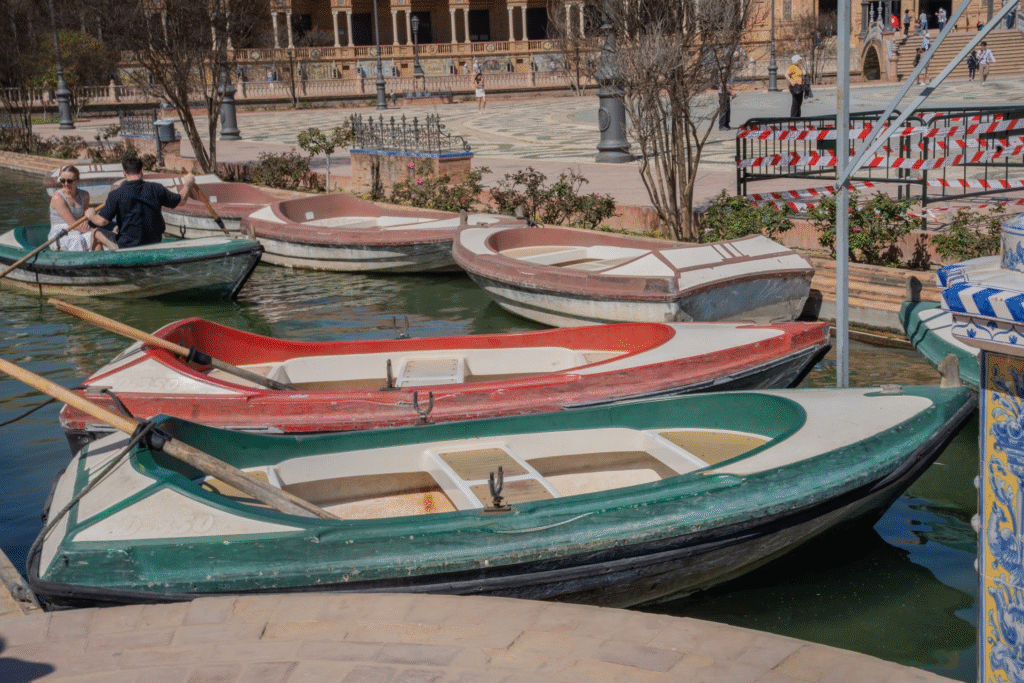
Nightlife Beyond Flamenco
While flamenco is Seville’s most famous evening entertainment, the city offers diverse nightlife. The scene starts late—tapas around 9:30 PM, then cocktails, with bars not crowding until after midnight. Sevillanos take their nightlife seriously, often staying out until 6-7 AM!
Main nightlife areas:
- Alfalfa: Packed with students and young people, especially Calle Pérez Galdós on weekends
- Alameda de Hércules: Alternative scene with LGBTQ+ bars, live music venues, and bohemian vibe
- Calle Betis (Triana): Riverside wall-to-wall venues from quiet bars to clubs
Notable spots: La Carbonería offers free nightly flamenco plus folk and jazz in an atmospheric former coalyard. Rooftop bars like EME Terraza and Torre Sevilla’s Terraza Atalaya (170m high, €16 entry including drink) provide stunning city views. November evenings are cool enough for outdoor terraces with a light jacket.
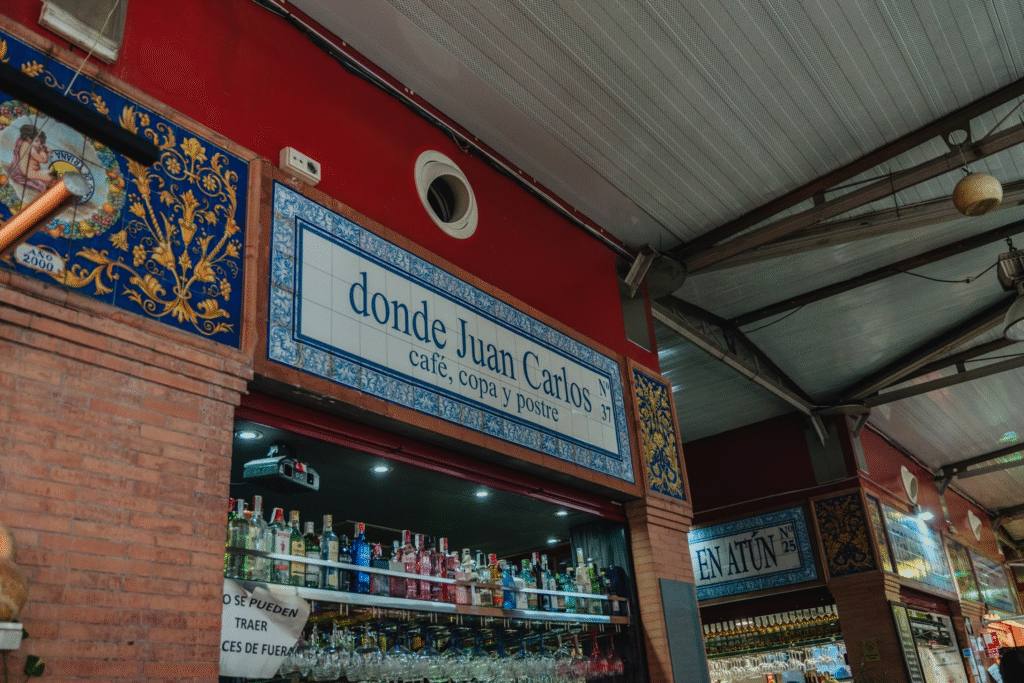
Practical Tips for November Visits
What to Pack: November weather is generally mild but can be unpredictable. Bring layers you can add or remove: light sweaters, a jacket for evenings, and a waterproof layer in case of rain. Comfortable walking shoes are essential—you’ll likely walk 10-20 kilometers per day exploring the city. Seville is very walkable, and many of the best discoveries happen when you’re simply wandering.
Booking Tickets: While November is less crowded than summer, it’s still wise to book tickets for major attractions like the Real Alcázar a day or two in advance, especially if you’re visiting on a weekend. Cathedral tickets can usually be purchased on arrival, but combination tours sell out faster.
Dining Schedule: Adapt to Spanish mealtimes for the best experience. Lunch runs from 2-4 PM, and dinner rarely starts before 9 PM. Many restaurants close between lunch and dinner service. For tapas, the best times are before lunch (12-2 PM) and in the evening (8-11 PM).
Beyond Seville: Day Trip Options
Córdoba and the Magnificent Mezquita
Don’t miss a day trip to Córdoba—just 40 minutes away via high-speed AVE train from Santa Justa station. The star attraction is the Mezquita-Cathedral, a UNESCO World Heritage Site that’s unlike anything else in the world. Originally built as a grand mosque in the 8th century, it was converted into a Catholic cathedral after the Reconquista—but the Islamic structure was preserved, creating a stunning architectural fusion.
Check out 1 Day in Cordoba.
Walk through over 850 columns supporting the famous red and white striped double arches in the “forest of columns,” then discover the ornate Catholic cathedral built right in the center. Beyond the Mezquita, wander Córdoba’s charming Jewish Quarter with its narrow streets and flower-filled patios, and cross the Roman Bridge for classic photo opportunities.
Train tickets cost €12-25 each way (book 1-2 days ahead). Arrive around 9-10 AM and depart 5-7 PM for a comfortable day trip. November’s cooler temperatures make this excursion perfect—Córdoba can be even hotter than Seville in summer.
Other Andalusian Gems
Granada and the legendary Alhambra are about 2.5 hours away—worth visiting if you have an extra day, though the Alhambra requires advance booking weeks ahead. The white villages of the Pueblos Blancos route offer stunning scenery and traditional Andalusian culture. Coastal cities like Cádiz are also accessible for a day trip if you’re craving sea air and fresh seafood, while Ronda, perched dramatically atop a gorge, makes for an unforgettable excursion.
Final Thoughts
Seville in November offers the rare combination of ideal weather, manageable crowds, and authentic cultural experiences. You’ll have the space and comfort to truly appreciate one of Spain’s most beautiful cities without the compromises that come with peak season travel.
The city’s blend of Moorish heritage, Catholic grandeur, flamenco passion, and Andalusian warmth creates an atmosphere unlike anywhere else in Europe. Whether you’re wandering through the Alcázar’s gardens, getting lost in Santa Cruz’s alleyways, or savoring tapas in a centuries-old bar, November provides the perfect backdrop for experiencing Seville at its most genuine.
Pack those layers, book your tickets, and prepare to fall in love with the Andalusian capital. Seville in November isn’t just a good time to visit—it might just be the perfect time.




